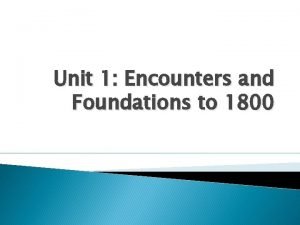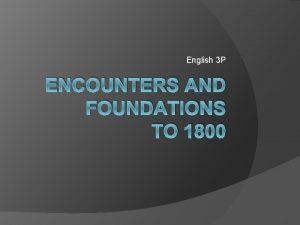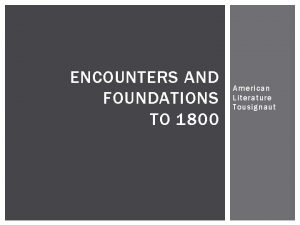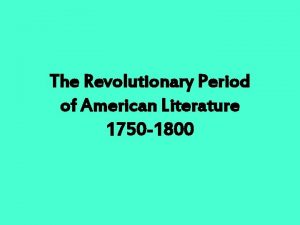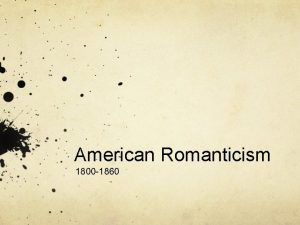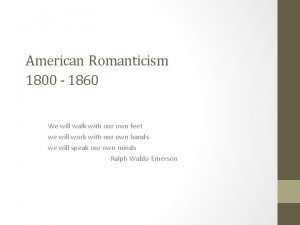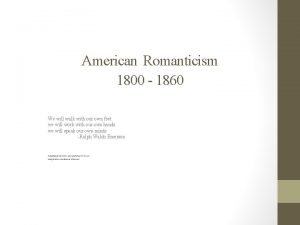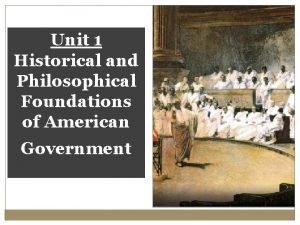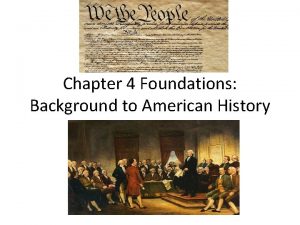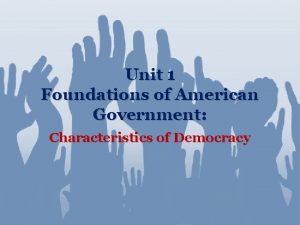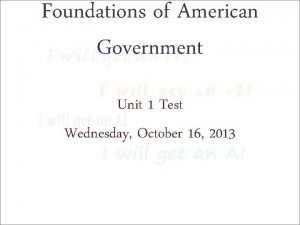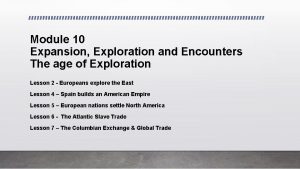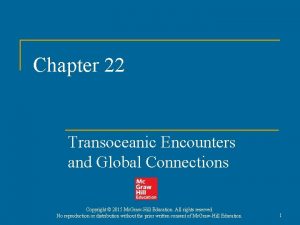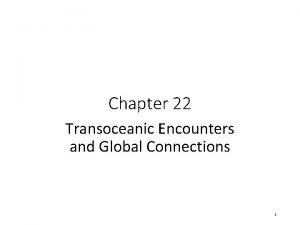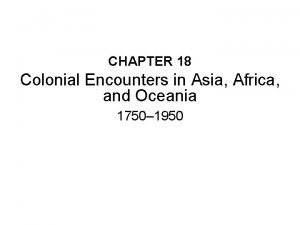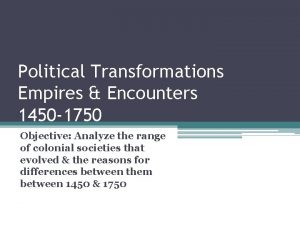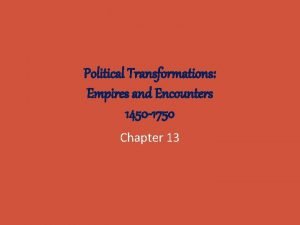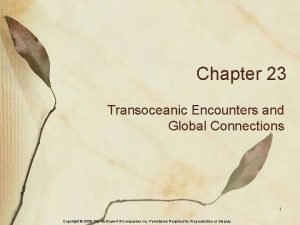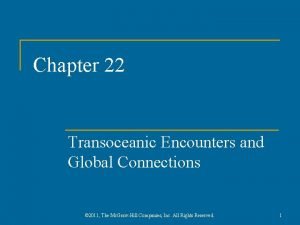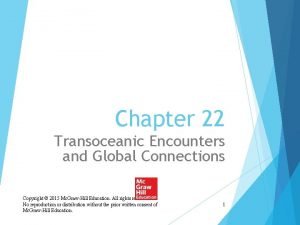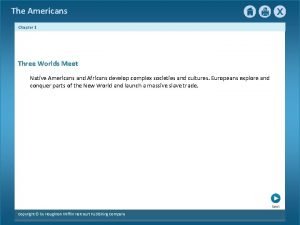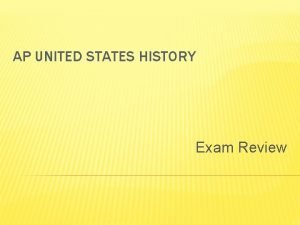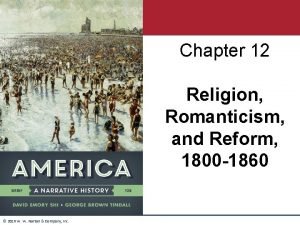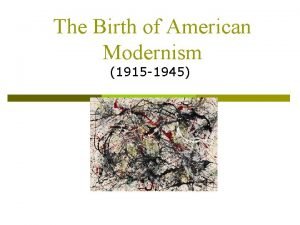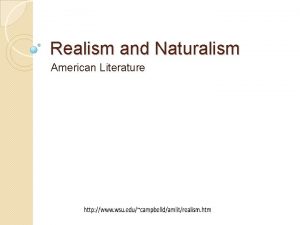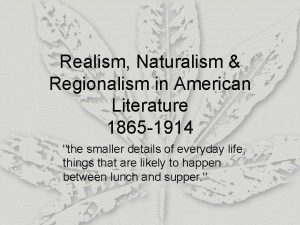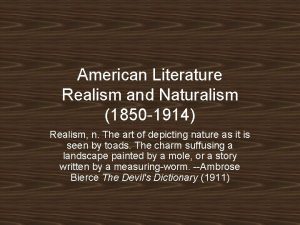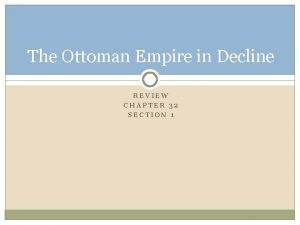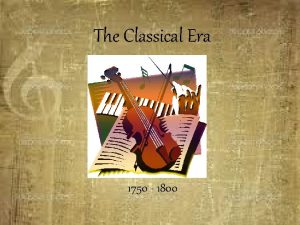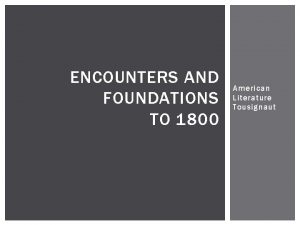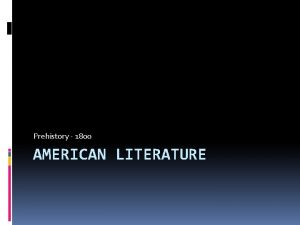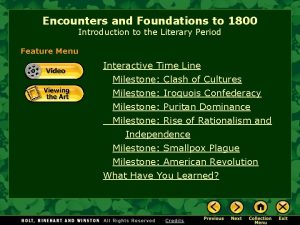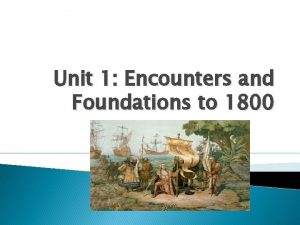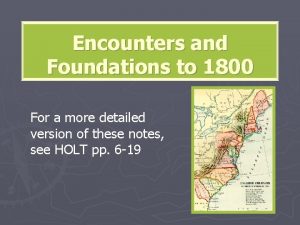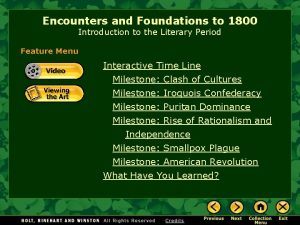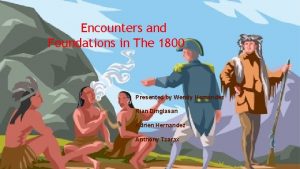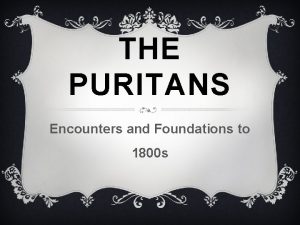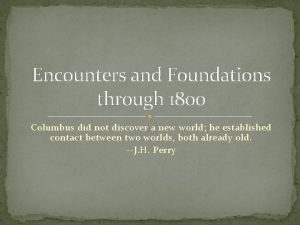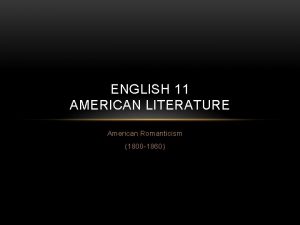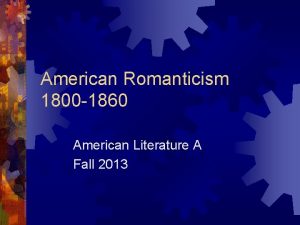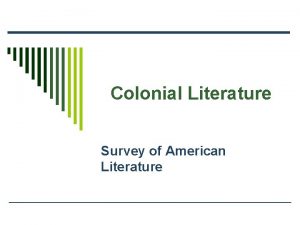ENCOUNTERS AND FOUNDATIONS TO 1800 American Literature Tousignaut




































- Slides: 36

ENCOUNTERS AND FOUNDATIONS TO 1800 American Literature Tousignaut

TERMS IN YOUR NOTES Example: Term autobiography apostrophe Synecdoche Initial Definition Learned Definition written about the author Punctuation at the end of sentence A figure of speech in which a speaker directly addresses an absent person or a personified object, quality, or idea. When one piece stands for the whole (all hands on deck)

LIST OF TERMS Myth Cultural Details Origin Myth Archetype Oral Tradition Exploration Narrative Sermon Autobiography Puritan Plain Style Diction Chronological Order Apostrophe Inversion Allusion Rationalism Slave Narrative Deism Charged Words Aphorism Ornate Style Rhetorical Devices Persuasion Figure of Speech

LIST OF TERMS (NA FOCUS) Myth Cultural Details Origin Myth Archetype Oral Tradition Exploration Narrative Sermon Autobiography Puritan Plain Style Diction Chronological Order Apostrophe Inversion Allusion Rationalism Slave Narrative Deism Charged Words Aphorism Ornate Style Rhetorical Devices Persuasion Figure of Speech

NATIVE AMERICAN TERMS Myth: Stories, usually connected with religious rituals, explaining the world the people live in and their traditions. They give a sense of cultural identity. Passed down by word of mouth (see oral tradition). Example: NA have Sky Tree etc. Today we have urban legends. Archetypes: An old imaginative pattern that appears across cultures and is repeated across cultural and national boundaries. Example: Plot—boy meets girl; characters—damsel in distress; or image/place—fountain of youth. Oral Tradition: Stories passed down by word of mouth. They depend on dynamic speaker not only for delivery but also might alter with each telling. Example: Think of how a story changes after you tell it a few times.

NATIVE AMERICAN TERMS (CONTINUED) Cultural Details/Characteristics: References to objects, animals, or practices that reflect aspects of daily life or prevalent attitudes Example: We can learn about the Greek culture by reading the Odyssey Origin Myth: Stories or myths explaining how life began, customs, traditions, religious rites, natural landmarks, and events beyond people’s control Exploration Narrative: First hand accounts of travels.

CHARACTERISTICS OF N. A. LIT. Native American Literature was entirely oral N. A. originally viewed mainly as folklore The telling of the tale may change with each speaker The language is poetic and moving N. A. produced a diverse body of literature Shows a deep respect for nature Celebrates the wonders of the natural world Stress the cyclical nature of existence Shows interconnectedness with the spirit world

WHY NATIVE AMERICAN MYTHS? Native American Myths indirectly teach the values, ideals, and customs of a particular culture

TYPES OF NATIVE AMERICAN LITERATURE Song lyrics Hero Tales Migration legends Creation Accounts

WHAT ARE MYTHS ABOUT? Creation Natural phenomena Origins of humans Customs Events beyond control Institutions of religious rites of people

ORIGIN MYTHS Explain how life began on earth and traditional stories passed down from generation to generation. They explain phenomena such as customs, religious rites, natural landmarks such as a great mountain or events beyond control

ORAL TRADITIONS Captures a groups ideals Stories, poems and songs convey a people’s values, concerns, and history by word of mouth

CULTURAL DETAILS While reading, notice references to objects, animals, or practices that show the people of a culture live, think, or worship.

EVALUATE: NATIVE AMERICAN MYTH 1. 2. 3. 4. Title of Myth: Why was this myth told/written (purpose)? What does the myth explain? List and explain three symbols/archetypes used in the myth. A B C 5. List three cultural details/characteristics that you can infer from the myth about the people who made it? A B C

WRITING #1 Create your own mythical accounts of creation. Use details from the regions in which they were born and from their ancestral heritage to create a story (myth). Students should include the use of several narrative techniques, including dialogue and sensory details, to further the development of your stories. Address at least two of the following ideas: § § § The The The creation of the universe (something from nothing) existence of evils and death creation of men/women and their companions relationship between man and his/her creator life cycle Myth needs to be roughly two pages.

LIST OF TERMS (PURITAN FOCUS) Myth Cultural Details Origin Myth Archetype Inversion Allusion Sermon Deism Charged Words Aphorism Autobiography Puritan Plain Style Oral Tradition Exploration Narrative Diction Chronological Order Apostrophe Rationalism Slave Narrative Ornate Style Rhetorical Devices Persuasion Figure of Speech

PURITAN TERMS Allusion: A reference to someone or something that is known from history, literature, religion, politics, sports, science, or some other branch of culture Sermon: A speech given from a pulpit in a house of worship that conveys to an audience the speaker’s message or point of view; formal public speaking by a religious person. Puritan Plain Style: Style that emphasizes uncomplicated sentence structures and common diction to show glory to God and not to the writer Ornate Style: Elaborate style of writing in 1600 s England where classical allusions, Latin quotations, and elaborate figures of speech where common

PURITAN TERMS (CONTINUED) Inversion: Changing the structure of a sentence from the normal syntax (common among poets to aid in rhyme) Slave Narrative: Autobiographical account of life as a slave Diction: Word choice Chronological Order: Writer placing events in the order that they occurred. Figure of Speech: aka figurative language, a word or phrase that describes one thing in terms of something else and that is not meant to be taken literally. (simile, metaphor, personification, and symbol)

CHARACTERISTICS OF PURITAN WRITING Bible provides the model View life as a journey to salvation Diaries and letters are most common Show signs of Grace Purpose: To Worship God

PHILOSOPHY OF PURITANS Sought to “purify” the Church of England Response to Henry VIII Clergy or Gov’t should not act as an intermediary between individual and God Most of humanity damned due to Adam and Eve (disobedience) Hard work and self sacrifice Reward in the afterworld Everything for the glory of God

PURITAN PLAIN STYLE Style that emphasizes uncomplicated sentence structures and common diction Differed from Ornate or “high style” of the time To show glory to God and not to the writer Stresses simplicity and clarity of expression

ARE AMERICANS STILL PURITAN? Read the following article and be ready to discuss with your class. http: //www. nytimes. com/2012/08/05/opinion/sunday/areamericans-still-puritan. html? _r=2

HOMEWORK Bring in lyrics to your favorite love song (school appropriate as always)

#2: PURITAN STYLE Rewrite your Origin myth. (Must have your myth draft) Using Puritan Plain Style, rewrite your origin myth. Tell essentially the same story, but put it in the no nonsense, to the point style of the Puritans. Be sure to have diction and syntax in contemporary style (use todays words to demonstrate the style of the puritans). Keep the focus similar to the Puritans, God oriented. Should be two pages for the puritan.

READ THE CRUCIBLE Use PPT with Mc. Carthyism

LIST OF TERMS (COLONIAL FOCUS) Myth Cultural Details Origin Myth Archetype Sermon Autobiography Puritan Plain Style Oral Tradition Exploration Narrative Diction Chronological Order Apostrophe Inversion Allusion Rationalism Slave Narrative Deism Charged Words Aphorism Ornate Style Rhetorical Devices Persuasion Figure of Speech

COLONIAL TERMS Autobiography: Usually written in first person, autobiographies present life events as the writer sees them. They also provide a view of history that is more personal Rationalism: the belief that human beings can arrive at truth by using reason, not relying on past authority (king), religious faith (church), or intuition (chance). Deism: Believed in the perfectibility of humans their inherent goodness. They rejected strict religions and rather focused on the common threads/principles that each religion shares.

COLONIAL TERMS (CONTINUED) Charged words: Likely to produce a strong emotional response. – Example: tyranny, which means “oppressive power” may evoke feelings of outrage. Aphorism: A brief, cleverly worded statement makes a wise observation about life Persuasion: One of four forms of discourse, which uses reason and emotional appeals to convince a reader to think or act in a certain way Rhetorical Devices: Techniques used for persuasive writing

CHARACTERISTICS OF COLONIAL WRITING Find truth using reason Mostly newspapers, pamphlets and political writings Many persuasive techniques Logic is a God-given gift, try to find order in universe

RHETORICAL DEVICES § Rhetorical question-is asked for effect and not actually for an answer. § Repetition-unifying property of repeated words, sounds, syllables, and other elements that appear in a work. § Rhyme-repetition of vowel sounds in accented syllables.

RHETORICAL DEVICES (CONTINUED) § Parallel structure- the repetition of words or phrases that have similar grammatical structures (parallelism) § Diction: word choice § Charged Words (loaded words) § Syntax: word order § Note: Inversion: the reversal of the normal word order in a sentence or phrase

ARISTOTLE'S TRIANGLE Pathos § Emotions § Imagination Ethos § Credibility § trust Logos § Logical § consistency

LISTEN TO PATRICK HENRY’S SPEECH When finished, 1. What is Henry’s Close your book and purpose in get out a piece of writing/delivering paper this speech? Answer these 2. Identify three of his questions… best/lasting arguments 3. What is his tone? 4. Is it effective? Why or why not.

FIND ONE EXAMPLE OF EACH IN PATRICK HENRY’S SPEECH IN VA. CONVENTION (1) Pathos § Emotions § Imagination (1) Ethos § Credibility § trust (1) Logos § Logical § consistency (1) Rhetorical Question (1) Repetition (1) Sound device § Rhyme, § Alliteration § etc. (1) Parallel structure (1) Diction, Charged words *Use paper started yesterday; due today (in basket)

WRITING #3: AUTOBIOGRAPHY Write 2+ page first person narrative on a personal experience. Be non fiction in nature, but your level of bias is within your control. § Be factual and detached from the event, for purpose (Equiano) § Have fun and exaggerate the event for entertainment (Franklin) § Anything in between, just be in control The event should be real and you should have had time to reflect on its repercussions. § At least five years ago Due WED after we return.

FIND EXAMPLES IN THOMAS PAINE’S CRISIS NO. 1 Pathos § Emotions § Imagination Ethos § Credibility § trust Logos § Logical § consistency Rhetorical Question Repetition Sound devices § Rhyme, § Alliteration § etc. Parallel structure Diction, Charged words
 Encounters and foundations to 1800
Encounters and foundations to 1800 Pencounters
Pencounters Foundations and encounters early american literature
Foundations and encounters early american literature Revolutionary period in american literature
Revolutionary period in american literature Romantic period american literature
Romantic period american literature American romanticism 1800 to 1860 worksheet answers
American romanticism 1800 to 1860 worksheet answers American romanticism 1800 to 1860 worksheet answers
American romanticism 1800 to 1860 worksheet answers American romanticism 1800 to 1860 worksheet answers
American romanticism 1800 to 1860 worksheet answers Philosophical foundations of the american revolution
Philosophical foundations of the american revolution Chapter 4 foundations background to american history
Chapter 4 foundations background to american history Unit 1 foundations of american government
Unit 1 foundations of american government Foundations of american government unit 1 test review
Foundations of american government unit 1 test review Expansion exploration and encounters
Expansion exploration and encounters Colonial encounters in asia africa and oceania
Colonial encounters in asia africa and oceania Traditions and encounters chapter 22
Traditions and encounters chapter 22 Chapter 22 transoceanic encounters and global connections
Chapter 22 transoceanic encounters and global connections Chapter 18 colonial encounters in asia and africa
Chapter 18 colonial encounters in asia and africa Political transformations empires and encounters
Political transformations empires and encounters Chapter 5 political transformations empires and encounters
Chapter 5 political transformations empires and encounters Chapter 23 transoceanic encounters and global connections
Chapter 23 transoceanic encounters and global connections Chapter 22 transoceanic encounters and global connections
Chapter 22 transoceanic encounters and global connections Traditions and encounters chapter 20
Traditions and encounters chapter 20 Transoceanic encounters and global connections
Transoceanic encounters and global connections Christ encounters
Christ encounters What are the critical lenses
What are the critical lenses Close encounters challenges
Close encounters challenges Chapter 1 three worlds meet answer key
Chapter 1 three worlds meet answer key Transatlantic encounters in history of education download
Transatlantic encounters in history of education download Chapter 12: religion, romanticism, and reform, 1800–1860
Chapter 12: religion, romanticism, and reform, 1800–1860 Modernism and experimentation in american literature
Modernism and experimentation in american literature Naturalism in literature definition
Naturalism in literature definition The romantic period in american literature and art
The romantic period in american literature and art Regionalism american literature
Regionalism american literature Realism
Realism Map of ottoman empire 1800
Map of ottoman empire 1800 Classical music eras
Classical music eras 9300 to 34800
9300 to 34800
